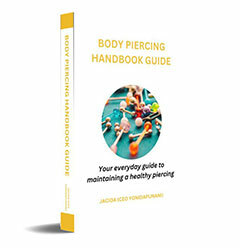Posted by YoniDa'Punani on 13th Oct 2022
Your Ultimate Guide To Body Jewelry

Whether you're interested in elevating your style with some much-needed accessorizing or trying to express yourself by using your piercings as a form of art, body jewelry is a hot topic you'd really want to dive deep into. If you're new to this concept, don't fret! In this article, we're sharing our ultimate guide to body jewelry with you: its meaning and origin, its different types, its ingredients, and our personal recommendation of where you can get the best body jewelry from.
Let's get right into it!
What is body jewelry?
Body jewelry is decorative items that are used to adorn your body, particularly for piercings. Those big hoops that your friend always likes to wear at parties and that nose ring that you're constantly trying to steal from your sister? Those are prime examples of body jewelry. Some view it as an accessory or a form of self-expression, whereas others consider it a cultural or religious statement. It's hard to trace the exact time when body jewelry became the new fad, but research has shown that it became a visible trend around the 1990s in the United States. Since then, there have been various kinds of jewelry manufactured that we're adorning ourselves with.
You'll have come across all sorts of retail kiosks in malls and plazas offering free piercings if you buy their latest jewelry. All this can be pretty overwhelming for someone who doesn't even know what the different types of body jewelry are! To clear up any confusion about this topic, we've laid out the basics for you right here.
What are the different types of body jewelry?
- Curved Barbell
A curved barbell, also known as CBB or horseshoe, is one of the most popular kinds of jewelry used for your septum and ear. You'll also notice it being a primary choice for navel, lip, cartilage, and nipple piercings as well. An example of this barbell is the J-Bar. As the name implies, it's in the shape of a J since it's curved at the bottom. The thickness of this piece can be typically measured as 16-18 gauge. However, that can differ according to the kind of curved barbell that you're interested in.
- Straight Barbell
These barbells are used mostly for tongue and nipple piercings. They're usually found around 14 gauge, but if you're looking for a genital piercing, you'll have to be careful about the gauge since it'll need to be heavier.
- Labret
A traditional piercing that can be dated back to 3000 BP amongst the American Northwest Coast Indians, the labret is a lip piercing that can be commonly seen today as well. This category consists of vertical labret, snakebites, spider bites, and lowbrets placed further down the chin. You can also use this for conch, tragus, and cartilage piercings. The gauge for these piercings varies from 16-18 gauge, with some going up to 19 gauge.
- Captive Bead Ring
This item carries a small ball or a bead within the ring's circle. Piercing lovers consider it a very convenient choice since you can quickly wear and remove it. It's close-ended, so it can't get stuck on your hair or clothes. If you've gotten a new piercing, captive bead rings and barbells are often used to help with the healing process. The ring gauge varies according to the piercing you're looking for; it can be used as an earlobe, nipple, nose, and lip piercing.
Now you know about the different kinds of jewelry you can find if you're going to get your next piercing soon. But you might be wondering, at this point, what exactly are these jewelry items made of? Here are some of the most common materials that you can expect to find:
●Metal: While most jewelry items are made of metal, you need to be wary of the specifics since low-quality metal, which is not properly inspected, can harm your piercing. Examples include stainless steel, sterling silver, gold, and titanium.
●Acrylic: This is an inexpensive, colorful and comfortable option you can try out if metal jewelry isn't your thing. However, make sure you don't wear it for too long since it can negatively affect your skin.
●Wood: Wood has only recently become a fan favorite due to its relatively safe and lightweight nature and the ease with which it can be cleaned. If you have an allergic reaction to specific types of wood, you should immediately remove the piercing.
●Glass: Tempered glass jewelry, which is deemed suitable by reputable organizations to be used as body jewelry, can immediately transform your style into chic and classy. Remember that these items aren't ideal during the healing or stretching process.
●Silicone: Lastly, we have silicone jewelry. This type is biocompatible, meaning it can not cause harm to your tissues. However, it's not a preferred option by some since it can stretch your piercing out and even cause buildup, which can lead to infection. If you want to test silicone jewelry, you'll need to ensure that you're buying from a reputable brand.
When choosing the perfect body jewelry items that you want to fit into your piercings, you need to be aware of the benefits and risks of the materials used to make them. It'd also benefit you if you list all your allergies so you can avoid them whenever there's a piece you feel like buying. You can also consult piercing experts or take an online quiz to determine which jewelry would match you the best.
Where can I find the best body jewelry?
All this talk about body piercings might have you wondering, where can I find the best body jewelry in town? This is where we come in!
Allow us to introduce you to the wonderful world of YoniDa'Punani, the one-stop shop for all your body jewelry needs. We're an online jewelry boutique that's exceedingly passionate about helping you find the best jewelry pieces that are safe, comfortable, and stylish. If you'd like to be one of the Homegirlz who are obsessed with our products, head on over to https://yonidapunani.com/ and make your purchase today!






